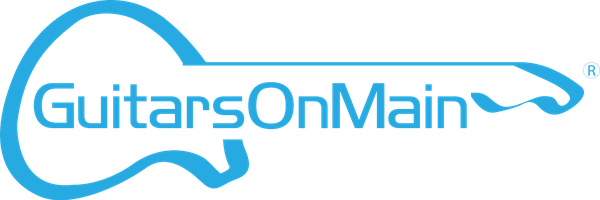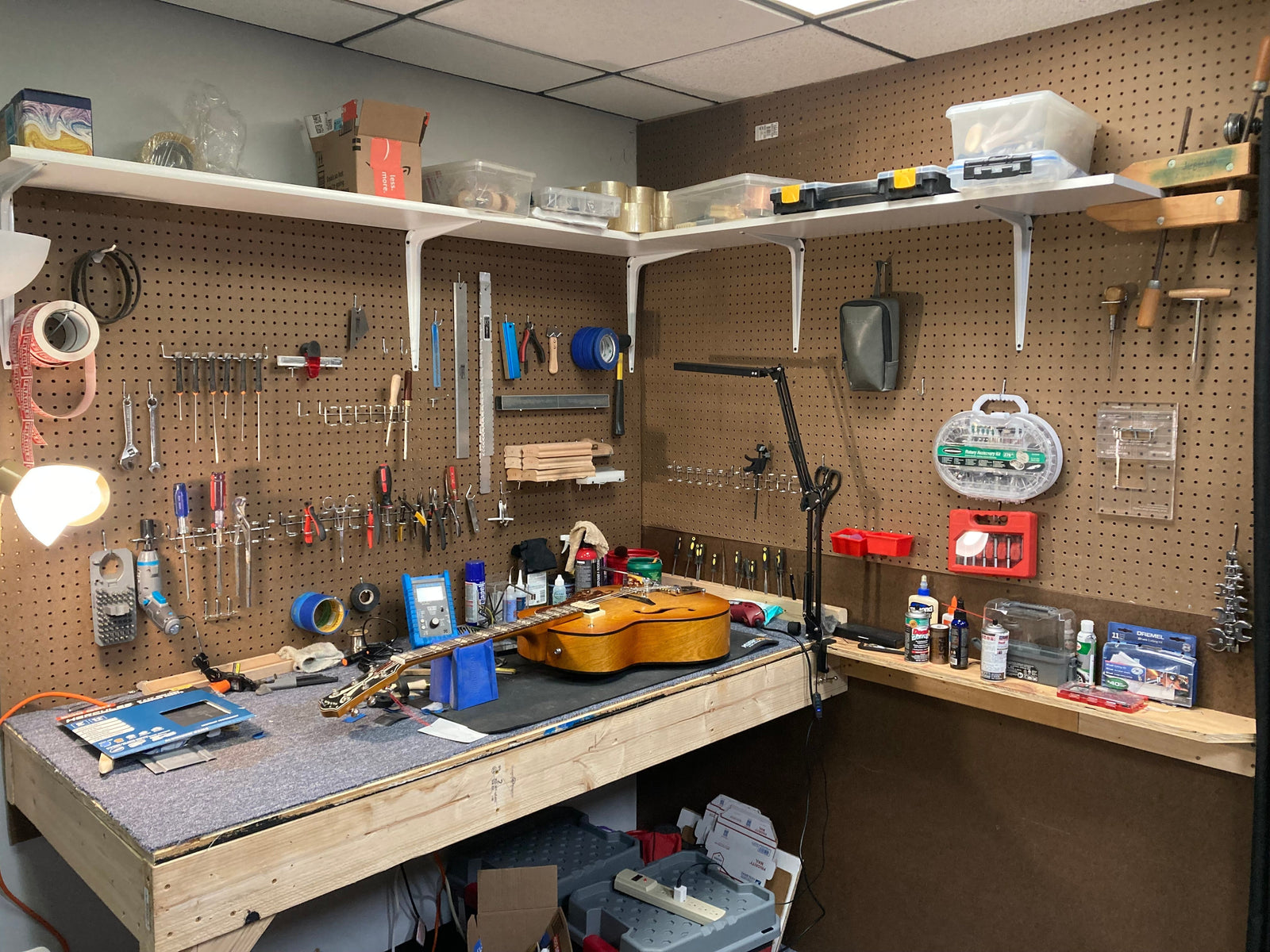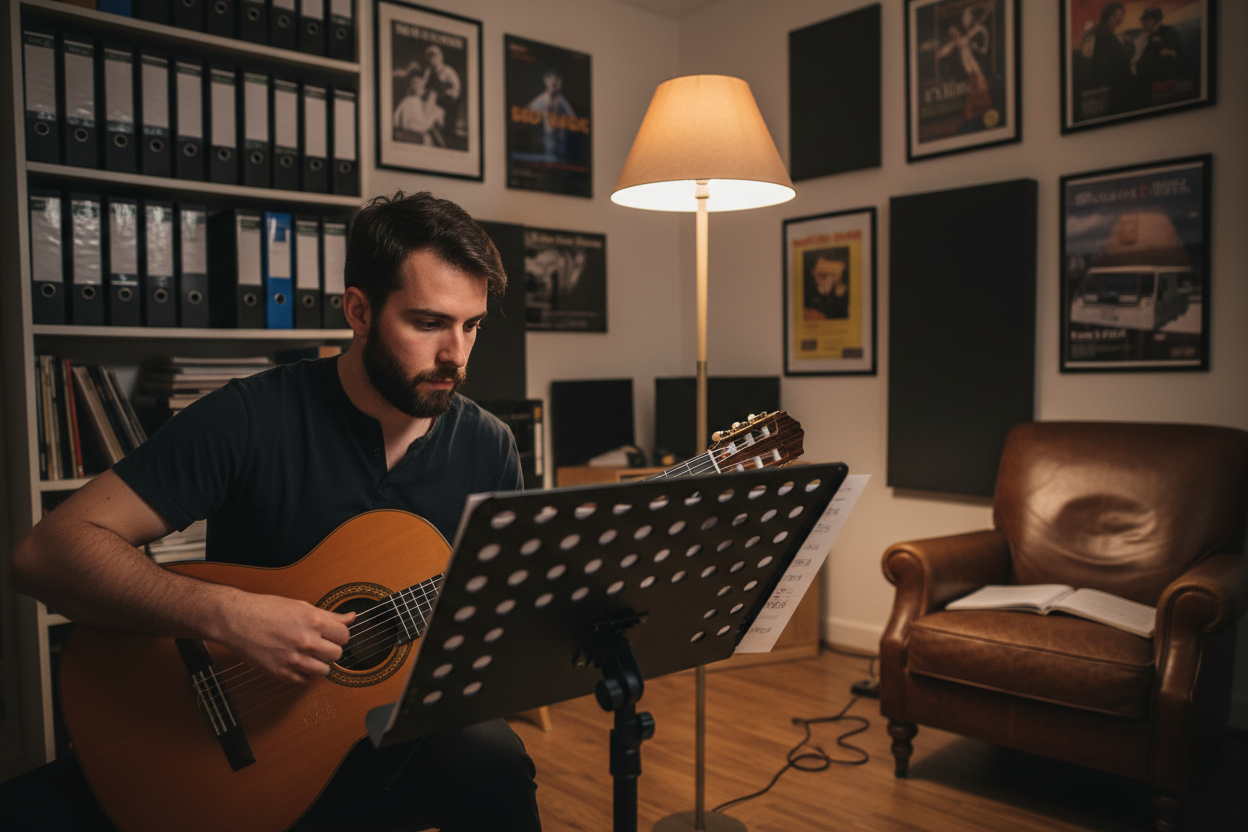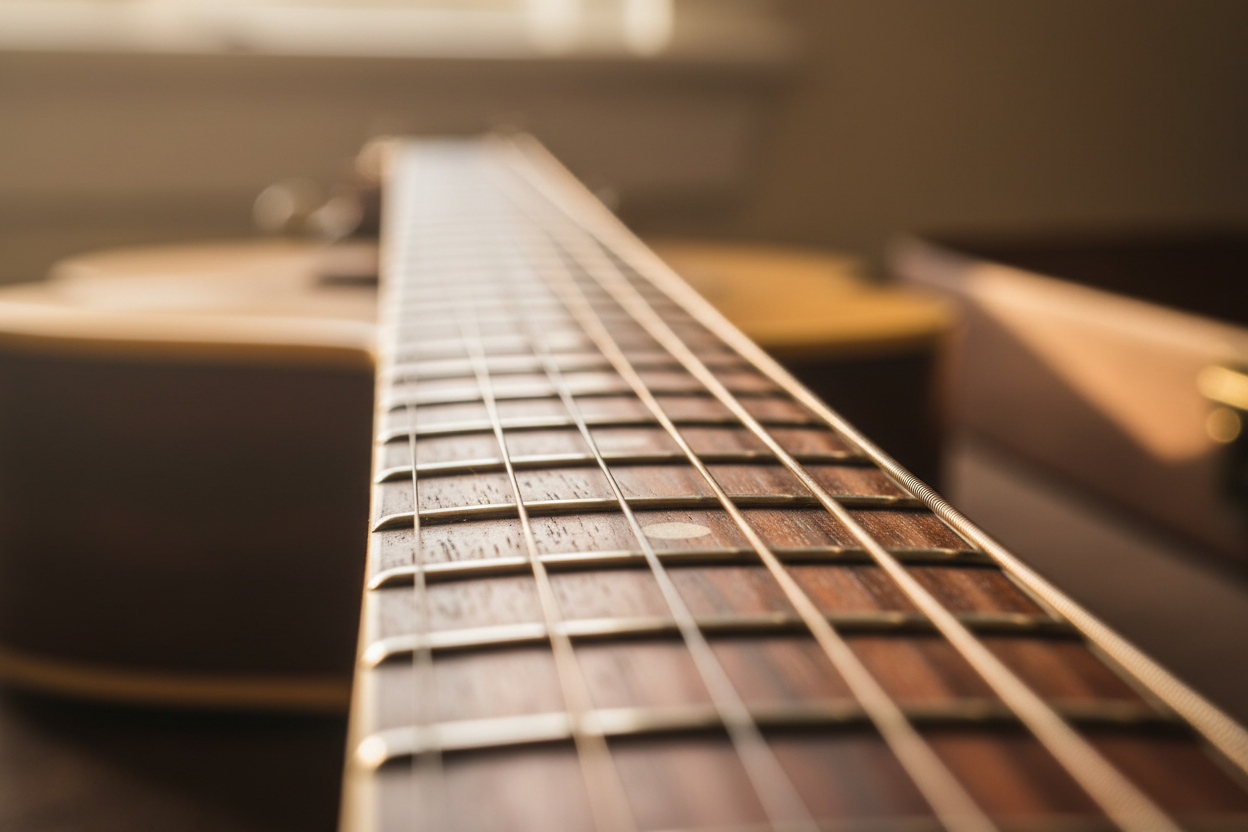This month’s issue is packed—and there’s excitement inside and outside the shop. 4th Friday Entertainment is back, and we’re kicking things off with the one-man band marvel Nick DiSanto performing live on our front porch May 23rd. Bring a lawn chair and catch the show from 5:30 to 7:30 PM (weather permitting).
We’re also reviewing a wallet-friendly pedal that nails the legendary Plexi tone, spotlighting our in-house guitar wizard Steve Miller (and his ZZ Top roots), and diving into the world of pickups—single coils, humbuckers, and everything in between. Whether you're chasing a new sound or just want your current rig to feel right in your hands, there’s something here for every guitarist who wants to play better, sound better, and connect more deeply with their instrument.
Off the Shelf: NUX Plexi Crunch Review

In the mid-1960's Marshall unleashed the Super Lead 1959 amplifier head on the world. This amp, with what looked like a plexiglass (hence, "Plexi") panel, was to be used with a pair of 4x12 cabinets or an 8x12, ushering into guitar vernacular two prominent terms: Plexi, and Marshall stack. Some illustrious users of the Plexi include Edward Van Halen, Pete Townshend, Angus and Malcolm Young, Jimi Hendrix, Randy Rhoads, Yngwie Malmsteen, George Lynch, and Ritchie Blackmore.
These legendary amplifiers defined the golden age of hard rock but come with a hefty price tag between $2000-$10000, placing them out of reach for most guitarists, not to mention the fact that their sound is instantly recognizable, but limited to just that incredible sound.
Over the years many manufacturers have attempted to copy the Marshall Plexi sound, with varying degrees of success, but it was pedal makers, not amp makers, who revolutionized the quest for the mythical Plexi tone. The market has been literally flooded with great examples of pedals that achieve the Plexi sound, costing between $200-$400, but the problem once again is the cost to consumers. Wouldn't it be nice if there was one that did the job for much less?
Enter the NUX Plexi Crunch pedal, one of many great pedals in the Reissue Series, an excellent group of affordable pedals including overdrives, distortions, delay, and chorus to fit your musical taste and your budget. Kick the $49 Plexi Crunch on when you need the sound of any of the acclaimed guitarists above. Kick it off when you don't. It turns a clean amplifier into a fire-breathing monster. It's that simple: one pedal, one click.
The pedal's four controls are simple, intuitive, and useful. Match or exceed your amp's volume with the Master knob. Cranking just that knob beyond unity gain yields some really satisfying AC/DC and The Who tones.
While that might be enough power amp-type drive for some, the Preamp knob is where all the extra saturation comes from. With the Master control at unity and the Preamp between 9-12 o'clock, juicy, defined, high gain tones similar to Jerry Cantrell of Alice in Chains are completely reachable. If you crank both, expect to be in high-gainy feedback lead guitar land. All three analog gain stages can be tailored with the Prescence and Tone knobs.
When you have arrived at your preferred level of gain, add in or subtract some high-end sizzle with the Prescence knob. This control can often add bite, definition, and clarity to any level of drive you can create with this pedal. If you boost this control, it's almost like having even more gain, ala a treble-booster, like Ritchie Blackmore used with Deep Purple. After 12 o'clock, this knob gets you into early Van Halen-era tones and makes it easy to produce and control musical feedback. This level of gain is enough to make your fretting hand work seem effortless, making long legato runs and super-sustained bends much smoother and easier to execute.
Shape the overall tone with the Tone knob to finish off your sound. It's easy to switch guitars or amps with this pedal, as it typically requires only one small twist of the Tone knob to go from a bright-sounding guitar or amp to a darker one. This knob is really different from the Prescence knob; it controls the amount of global treble, so there are two ways to sculpt your tone.
Most will use this pedal near the beginning of the pedal chain, right where overdrives and distortions belong, but, when the Plexi Crunch hits the front end of an amp that's already into breakup territory, hold onto your hat, because it's time for sonic mayhem! Either way, not having to carry around a head and full stack is worth the price of this pedal every time you have to set up.
All NUX pedals come from China, so, with the international tariff situation impacting imports right now, don't hesitate to pull the trigger on these excellent pedals while they're in stock at just $59. Once they're all sold, we can't guarantee when they'll be back.
On the Staff: Introducing Steve Miller, Guitar Tech Extraordinaire

Guitars on Main's own guitar tech goldmine, Steve Miller, has been working on guitars for over 30 years. He has a vast pool of experience beginning in 1991 with a tenure at Fender Musical Instruments in Cary, Illinois. There, he was a jack of all trades, working as a parts department manager, ensuring quality control, and building many "partscasters." At the same time, he had been working on guitars for local artists, friends, and family. This, plus the experience he gained at Fender spawned a passion for repairing, modifying, and improving instruments. Steve knows the temperament of electric and acoustic instruments, because he played guitar in a band in Illinois, where his family still lives.
Speaking of bands, Steve's love for ZZ Top in the 70's, especially songs like "La Grange," spurred his love for the guitar. Like countless modern players, Eddie Van Halen in the 80's obviously was an inspiration keeping his love affair with the guitar ablaze. In the 90's, it was Dinosaur Jr., featuring J Mascis, keeping the guitar out front in the mix and at the forefront of his listening. In the 2000's, Band of Horses scratched the same itch, among many others. A guitar tech needs to know about guitar tones and the interaction between the player and the instrument required to get those tones. His knowledge of music is encyclopedic, as are his abilities.
More than some credit goes to Steve's dad, however. He never allowed Steve to have a (too loud) drum set, so the guitar would be his instrument. His first guitar was a relatively quiet acoustic. The strings were so far from the fretboard, rendering it almost impossible to play. Steve's first tech-epiphany was that this guitar was terrible, so he saved up enough to buy an electric guitar, a green Hondo from Perry's Music in Villa Park, Illinois. It played so much easier, so he was hooked. He never touched that acoustic again, but, ironically, knows now that all it needed was some TLC and a good setup.
That experience of attempting to play that dreadful acoustic, contrasted with the relative ease of playing his Hondo, highlighted the importance of a well set up guitar. Before there was the internet and YouTube videos on everything, Steve had to study books by Dan Erlewine, etc., which set up his deep dive into all things tech. After some failed experiments in modding, he learned the hard way that everything takes time, patience, and skill; a solid gameplan beforehand is a good first step; always use the proper tools for the job.
Steve is a completely thorough tech. He treats all his customers' guitars with even more attention to detail than his own instruments. He understands the connection players have with their instruments and the critical importance of feel and tone. There is no guesswork here: the player will provide all the telltale signs to Steve, who believes that any time you can gain information about the player, the better off the repair will be. A famous tech anecdote that stuck with Steve is about one-time EVH guitar tech, Tom Weber. Weberknew from the first time he shook Eddie's hand, feeling his tremendous grip strength, that he would have to tune the guitar slightly flat to compensate for Eddie's heavy touch. As a guitar tech, Steve realizes that every guitar player is different, and every instrument needs to be set up to match the player.
Unfortunately, many manufacturers do not provide even an adequate setup out of the box. This then becomes the retailer's responsibility at their cost, which translates to either more expense to retailer, the customer, or both. Here, at Guitars on Main, if a guitar in inventory doesn't meet players' specifications, that guitar will be setup properly before the customer gets their hands on it. If a customer has singular specs, the shop can often make the changes right then and there. As long as the guitar is a good enough foundation, a decent guitar with a great setup can rival a guitar that costs many times more.
Steve does have some tips and suggestions for how NOT to see him! Regulating temperature and humidity is the most important factor to consider when caring for your own instrument at home. Keeping instruments between 70-75 degrees Fahrenheit will maintain their playability, especially keeping them away from HVAC vents. As for humidity, between 45-50% relative humidity helps reduce fret sprout, neck warps, finish cracking, all avoidable services that Steve remedies all the time.
Additionally, learning how to adjust your own truss rod to achieve proper neck relief goes a long way to keeping your guitar setup throughout all four seasons. Adjusting pickup height for your own rig to achieve the best tone for your preferred tone helps, as well as tightening all hardware, such as tuners and strap buttons.
Steve has experienced the joys music in various ways during his entire life. He loves watching his own kids develop their passion for music on guitar. His daughter recently joined her first band! They can enjoy music for their entire lives, unlike many other pursuits which have a limited lifespan. Steve loves working with famous players but enjoys helping someone just starting out have the greatest chance to be able to make a positive connection with music.
Remember, a properly set up guitar makes the difference between a miserable experience and an enjoyable one. If you are struggling to play your guitar, like Steve did with his first acoustic, chances are it's never been setup properly, so come see why all the area's best players flock to Steve Miller.
On the Bench: Choosing the Right Guitar Pickup: To Mod or Not to Mod
One of the most important (and most easily modifiable) parts of an electric guitar is the pickup. This month's installment will help you sort through the sea of different pickup types out there, so you can make an informed choice about hot-rodding your axe. The pickup captures the sound of the vibrating string and sends it as an electrical signal to your pedals, amplifier, or direct box. How your sound is captured is often the key to your basic guitar sound.
Single Coil Pickups: These pickups are most commonly used on Stratocaster and Telecaster type guitars, a key element in all types of music. Their bright, articulate, and often crisp, tones make them fit into any mix without getting lost. Some legendary practitioners of the single coil religion are Jimi Hendrix, Eric Clapton, David Gilmour, Mark Knopfler, Rory Gallagher, Jeff Beck, John Mayer, Ritchie Blackmore, Stevie Ray Vaughn, and Hank Marvin.
Humbuckers: These pickups are ironically quieter (no hum) than single coil pickups, but much, much louder. They use two sets of coils side by side to cancel out the 60-cycle hum created by single coil pickups. As such, they have a much higher output and warmer, thicker sound loved by players of all genres. One of the most common S-type mods is to replace the bridge single coil with a humbucker. Some instantly recognizable humbucker users include Jimmy Page, Slash, Tony Iommi, Eddie Van Halen, Angus Young, Joe Perry, Zakk Wylde, Carlos Santana, Randy Rhoads, and Gary Moore.
Active Pickups: Active pickups require a source of power, usually an onboard 9v battery. The downside is that you'll have to modify your guitar, unless there is already a cavity for a battery. The upside is that these pickups are high output, super quiet, and consistent in tone throughout the volume range. More often than not, hard rock and metal players reap the benefits of these pickups. Some of the more notable players include James Hetfield, Kirk Hammett, Zakk Wylde, Kerry King, Ola Englund, Gus G., and Stephen Carpenter.
Firebird Humbuckers/Mini Humbuckers: If you can't decide between the clarity of a single coil or the girth and volume of a humbucker, the good news is that you don't have to look at these variables as mutually exclusive. Get the best of both worlds with a mini humbucker, like the Firebird pickup. These pickups sound incredible and perform excellently anywhere single coils or humbuckers would work. Some famous players using mini humbuckers are Johnny Winter, Allen Collins, Brian Jones, Warren Haynes, Eric Clapton (with Cream), Gary Clark Jr., and Joe Bonamassa.
Lipstick Pickups: These pickups look like they're wrapped in a lipstick tube and sound out of this world. Danelectro put the lipstick tube pickup on the American music map, and just about every guitar hero of the 60's (and later) used these at one time or another. These low-output pickups have a characteristically jangly and raw sound and edgy chrome look, perfect for rock and roll. Some players who pioneered their own sonic careers with lipstick pickups include Jimmy Page, Jimi Hendrix, Ry Cooder, Beck, Mark Knopfler, Eric Clapton, Chris Isaak, Link Wray, Eliot Smith, and Brian May.
Jazzmaster Pickups: These pickups have much larger, flatter polepieces than standard single coil pickups, giving them a warmer tone than single coils, and more output, but not as much as a humbucker. Surf rock, indie rock, and many forms of alternative rock was authored with these larger, overwound single coil pickups. Like all the other pickup types on this list, they have their own unique tonal twist. A few famous Jazzmaster pickup players include J. Mascis, Thurston Moore, Lee Ranaldo, Nels Cline, Elvis Costello, Tom Verlaine, Kevin Shields, Robert Smith, Jim Root, and Troy Van Leeuwen.
P90 Pickups: P90s are single coil pickups with a wider coil, giving them a warmer tone and much more output than a traditional single coil. These pickups boost the sound of the midrange frequencies, which some would argue are the most vocalesque of the guitar's sonic range. They produce a slightly driven, mid-focused tone that is perfect for the instrument. A short list of famous P90 players includes Leslie West, Les Paul, Pete Townshend, Carlos Santana, Billie Joe Armstrong, Keith Richards, Mick Jones, Freddie King, Steve Marriot, and Jack White.
Filter'Tron Pickups: Filter'Trons growl and drip with style. They combine clarity, power, articulation, and, most importantly, twang! Although they are notoriously finicky to set up (the twelve adjustable polepieces do not follow your string curvature), 'Tron pickups have turned up in many genres of music over the years, from country to hard rock. Some famous 'Tron players include Chet Atkins, Brian Setzer, Malcolm Young, George Harrison, Bo Diddley, Billy Duffy, Don Peris, and Pete Townshend.
And Now for Something Completely Different:

Seymour Duncan P-Rails might very well be the most versatile pickup on the planet. It's a humbucking pickup that comprised of two different single coil pickup types: a single coil blade on one side, and a P90 on the other, with the wiring capacity to use all three. The pickup types are switchable with either push/pull pots or a special pickup ring made by Seymour Duncan for this particular pickup, called the Triple Shot. You can easily switch from a single coil sound to a P90 sound, to a humbucker sound, to suit your sonic needs. All three voices are distinct, genuine, and right at your fingertips--truly the best of all worlds. The shop carries them, too!
4th Friday Entertainment Returns This Month!

We’re kicking off this season’s 4th Friday festivities with the incredible Nick DiSanto—a true one-man band! Join us Friday, May 23rd from 5:30 to 7:30 PM right on our front porch at Guitars on Main for a fun and family-friendly evening of live music.
Nick’s multi-instrumental performances are always a hit. Whether you're a long-time local or just passing through, bring a lawn chair, grab a good spot on the sidewalk, and enjoy the show.
Weather permitting. Follow us on Facebook or check our site for updates if the skies look iffy.
Conclusion
From dialing in classic tones with the NUX Plexi Crunch to understanding why your pickup choice matters, this month’s roundup is all about helping you get more out of your gear—and yourself. And if Steve’s story reminded you how much a proper setup can change everything, maybe it’s time to bring your own guitar in for some TLC. Got questions about mods, pedals, or repairs? We’re here to help you make the most of your musical journey, one note at a time.
— The Team at Guitars on Main




